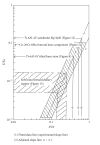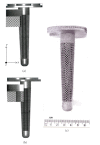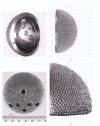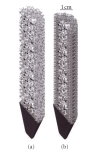Next generation orthopaedic implants by additive manufacturing using electron beam melting
- PMID: 22956957
- PMCID: PMC3432366
- DOI: 10.1155/2012/245727
Next generation orthopaedic implants by additive manufacturing using electron beam melting
Abstract
This paper presents some examples of knee and hip implant components containing porous structures and fabricated in monolithic forms utilizing electron beam melting (EBM). In addition, utilizing stiffness or relative stiffness versus relative density design plots for open-cellular structures (mesh and foam components) of Ti-6Al-4V and Co-29Cr-6Mo alloy fabricated by EBM, it is demonstrated that stiffness-compatible implants can be fabricated for optimal stress shielding for bone regimes as well as bone cell ingrowth. Implications for the fabrication of patient-specific, monolithic, multifunctional orthopaedic implants using EBM are described along with microstructures and mechanical properties characteristic of both Ti-6Al-4V and Co-29Cr-6Mo alloy prototypes, including both solid and open-cellular prototypes manufactured by additive manufacturing (AM) using EBM.
Figures
















Similar articles
-
Microstructure and mechanical properties of open-cellular biomaterials prototypes for total knee replacement implants fabricated by electron beam melting.J Mech Behav Biomed Mater. 2011 Oct;4(7):1396-411. doi: 10.1016/j.jmbbm.2011.05.010. Epub 2011 May 12. J Mech Behav Biomed Mater. 2011. PMID: 21783150
-
Next-generation biomedical implants using additive manufacturing of complex, cellular and functional mesh arrays.Philos Trans A Math Phys Eng Sci. 2010 Apr 28;368(1917):1999-2032. doi: 10.1098/rsta.2010.0010. Philos Trans A Math Phys Eng Sci. 2010. PMID: 20308113
-
Osteoconductivity of bioactive Ti-6Al-4V implants with lattice-shaped interconnected large pores fabricated by electron beam melting.J Biomater Appl. 2021 Apr;35(9):1153-1167. doi: 10.1177/0885328220968218. Epub 2020 Oct 26. J Biomater Appl. 2021. PMID: 33106079
-
Open-cellular metal implant design and fabrication for biomechanical compatibility with bone using electron beam melting.J Mech Behav Biomed Mater. 2017 Dec;76:164-177. doi: 10.1016/j.jmbbm.2017.02.019. Epub 2017 Feb 27. J Mech Behav Biomed Mater. 2017. PMID: 28259731 Review.
-
Microstructure and mechanical behavior of Ti-6Al-4V produced by rapid-layer manufacturing, for biomedical applications.J Mech Behav Biomed Mater. 2009 Jan;2(1):20-32. doi: 10.1016/j.jmbbm.2008.05.004. Epub 2008 May 29. J Mech Behav Biomed Mater. 2009. PMID: 19627804 Review.
Cited by
-
The Evolution, Current Indications and Outcomes of Cementless Total Knee Arthroplasty.J Clin Med. 2022 Nov 8;11(22):6608. doi: 10.3390/jcm11226608. J Clin Med. 2022. PMID: 36431091 Free PMC article. Review.
-
Powder based additive manufacturing for biomedical application of titanium and its alloys: a review.Biomed Eng Lett. 2020 Oct 26;10(4):505-516. doi: 10.1007/s13534-020-00177-2. eCollection 2020 Nov. Biomed Eng Lett. 2020. PMID: 33194244 Free PMC article. Review.
-
Trends and developments in hip and knee arthroplasty technology.J Rehabil Assist Technol Eng. 2021 Feb 8;8:2055668320952043. doi: 10.1177/2055668320952043. eCollection 2021 Jan-Dec. J Rehabil Assist Technol Eng. 2021. PMID: 33614108 Free PMC article. Review.
-
Unique Device Identification-Based Linkage of Hierarchically Accessible Data Domains in Prospective Surgical Hospital Data Ecosystems: User-Centered Design Approach.JMIR Med Inform. 2023 Jan 27;11:e41614. doi: 10.2196/41614. JMIR Med Inform. 2023. PMID: 36705946 Free PMC article.
-
Three-dimensional printing of metals for biomedical applications.Mater Today Bio. 2019 Aug 20;3:100024. doi: 10.1016/j.mtbio.2019.100024. eCollection 2019 Jun. Mater Today Bio. 2019. PMID: 32159151 Free PMC article. Review.
References
-
- Bronzino JD, editor. The Biomedical Engineering Handbook. Vol. 1. Boca Raton, Fla, USA: CRC Press; 2000.
-
- Christel P, Meunier A, Lee AJC, editors. Biological and Biomechanical Performance of Biomaterials. New York, NY, USA: Elsevier; 1986.
-
- Yang S, Leong KF, Du Z, Chua CK. The design of scaffolds for use in tissue engineering. Part I. Traditional factors. Tissue Engineering. 2001;7(6):679–689. - PubMed
-
- Cahoon JR. On the corrosion products of orthopedic implants. Journal of Biomedical Materials Research. 1973;7(4):375–383. - PubMed
-
- Ryan G, Pandit A, Apatsidis DP. Fabrication methods of porous metals for use in orthopaedic applications. Biomaterials. 2006;27(13):2651–2670. - PubMed
LinkOut - more resources
Full Text Sources
Other Literature Sources

